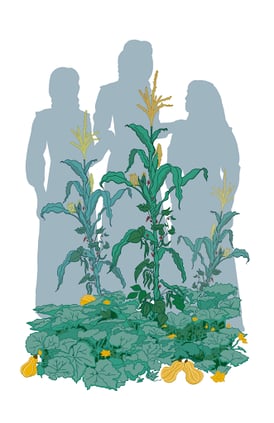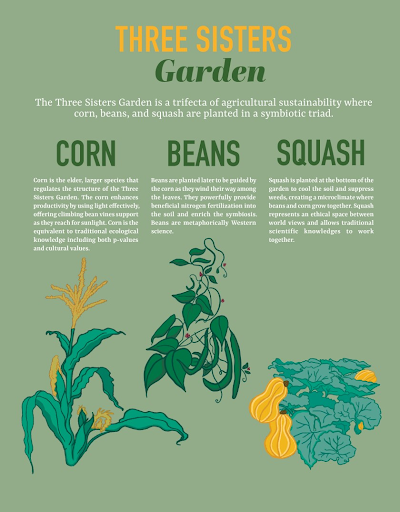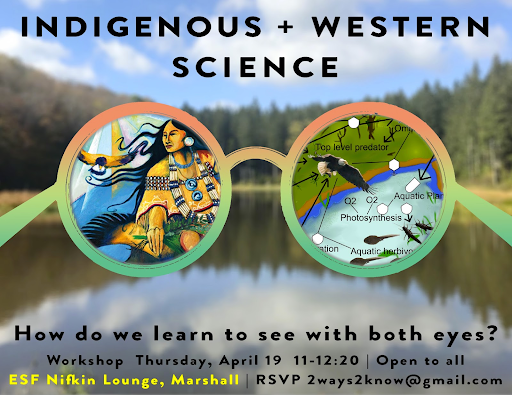Dr. Robin Wall Kimmerer is a professor, scientist, and author who has inspired people with her words, which contain lessons on reconnecting with the land and developing a kinship with all earth’s living beings. In mid-October, Walking Mountains’ Youth Programs team was able to tune into the National Association for Environmental Education (NAAEE) Conference to see Dr. Kimmerer’s keynote address. She spoke about the role of environmental educators in shifting their teaching about the natural world to include both traditional ecological knowledge (TEK) and scientific ecological knowledge (SEK). Using metaphor as a teaching tool, Dr. Kimmerer offered conference-goers the Three Sisters’ Garden as a model for this symbiosis between the two knowledge systems.
On Thursday, October 13th, the Youth Programs team at Walking Mountains Science Center had the professional development opportunity to tune into the annual North American Association for Environmental Education (NAAEE) Conference.
The keynote speaker, Dr. Robin Wall Kimmerer, is a professor and scientist at SUNY-ESF, author of the well-loved book Braiding Sweetgrass: Indigenous Wisdom, Scientific Knowledge and the Teachings of Plants, and an enrolled member of the Citizen Potawatomi Nation.
Dr. Kimmerer explores relationships between humans and nature, finding ways to incorporate both Traditional Ecological Knowledge (TEK) and Scientific Ecological Knowledge (SEK), or western science, in her work.
I began my graduate fellowship with Walking Mountains in May, and am one of eight educators who make up the Youth Programs Team. Throughout this 2-year, 3-month fellowship, we work full time as field science educators and take classes with Walking Mountains faculty and online through the University of Northern Colorado to earn a Master’s in Science Education.
The beauty of this program is that we have opportunities to apply what we are learning in our classes directly to our teaching practice. In our course, “Teaching Culturally and Linguistically Diverse Learners,” we learn techniques to help us better serve bilingual and English Language Learning students. In “Program Design and Planning,” we learn to create age-appropriate, standards-based curriculum.
And now, through the opportunity to hear Dr. Kimmerer speak, we learn to reconsider the lens through which we teach children about natural science.
In her presentation, Dr. Kimmerer used metaphor as a tool to help us understand the nature of science, and the role that TEK and environmental educators can have in creating more holistic, inclusive, and immersive learning experiences for students.
The metaphor she claimed is most relevant and powerful for our time is the Three Sisters Garden. In this garden, three separate plants support and nourish each other, which leads to their mutual flourishing: Corn, Beans, and Squash.

Caption: In the Three Sisters Garden, both TEK and SEK become our teachers. These knowledge systems can be mutually beneficial while also maintaining their sovereignty. There is no blending in this garden, but there is mutual support. Photo by Emily Tribe, from: https://lifesciences.byu.edu/magazine/the-garden-of-scientific-perspectives.
Corn provides structure for the beans to grow so there is no competition between Beans and Squash. Beans convert nitrogen into a usable form for the other plants, thus providing essential nutrients. And finally, the large Squash leaves provide low ground cover, which creates a microclimate and keeps the soil moist for the other plants.
Using this metaphor, Dr. Kimmerer proposed a new model for environmental education. One in which educators learn to see the land through the lenses of both TEK and SEK.
TEK includes the collective knowledge of indigenous peoples that has been gathered over hundreds or thousands of years, and continues to evolve today. TEK focuses on the inherent personhood and sacredness of nature.
“TEK has a legitimate place in the education of the next generation of environmental scientists,” Dr. Kimmerer wrote in the Journal of Environmental Studies and Sciences in 2012. “Yet this body of knowledge and the process by which it is generated are virtually absent from the environmental science classroom.”
SEK, meanwhile, is seen as a powerful tool for analyzing ecosystem parts and finding connections between things like climate change and biodiversity loss. However, as Dr. Kimmerer wrote in the same 2012 article, SEK “has been far less successful in devising sustainable solutions which lie at the intersection of nature and culture.”
Dr. Kimmerer emphasized that while the two knowledge systems can be in symbiotic relationship they should also maintain their sovereignty.
In the Three Sisters Garden, Dr. Kimmerer proposed that Corn can be the TEK, which provides the intellectual scaffolding for SEK. The SEK can be guided and enriched by TEK. Meanwhile, the Squash are the environmental educators, who tend the soil for the other plants to grow.
In tending to that soil, Dr. Kimmerer proposed that environmental educators are uniquely placed to cultivate mutualism between the systems.

Caption: A short description of each of the members of the Three Sisters Garden in the context of
sustainable agriculture, which can be adapted to environmental education. Photo by Emily Tribe, from: https://lifesciences.byu.edu/magazine/the-garden-of-scientific-perspectives
This presentation made me reflect on my own teaching practice, and how I might be guided by TEK as I teach SEK to students in Eagle County. One of the most commonplace, yet powerful opportunities for change I see in my own teaching is the language I choose to use.
Language is powerful, and even using words like “it” to talk about a snail can reduce that snail to a thing, rather than one of our “more than human teachers,” as Dr. Kimmerer put it.
As I continue to work with students in Eagle County, I hope to educate for land care that improves biodiversity, invite students into a relationship with this place, and thus create a community around the work of restoring our relationship with the land.
 Caption: An image depicting the ability to see the world through the lens of both Indigenous and Western Science.
Caption: An image depicting the ability to see the world through the lens of both Indigenous and Western Science.
From: http://twoways2know.blogspot.com/
Written by Katie Geraci. Katie Geraci is a Walking Mountains Foley Graduate fellow. She writes about regenerative, sustainable agriculture, the power of language, and human relationships with nature. Her work has appeared in Edible Bozeman Magazine, Edible Communities Online, Montana Woman Magazine, and Get Out Chattanooga. Currently, Katie and her husband are building out a short school bus dubbed “The Prancing Pony.”







